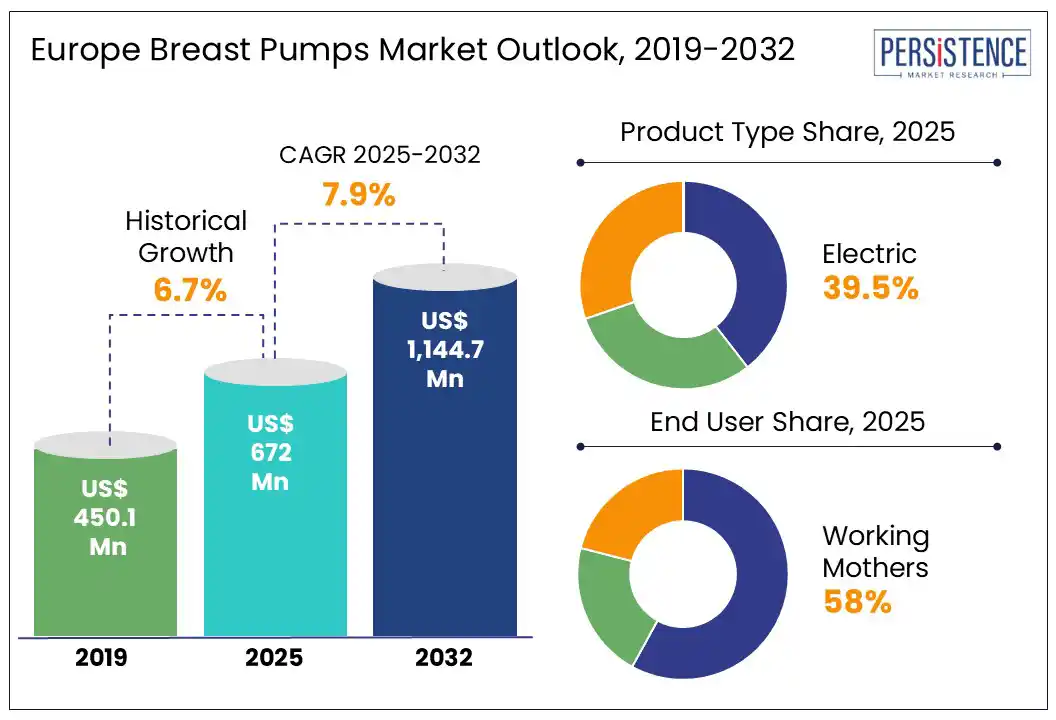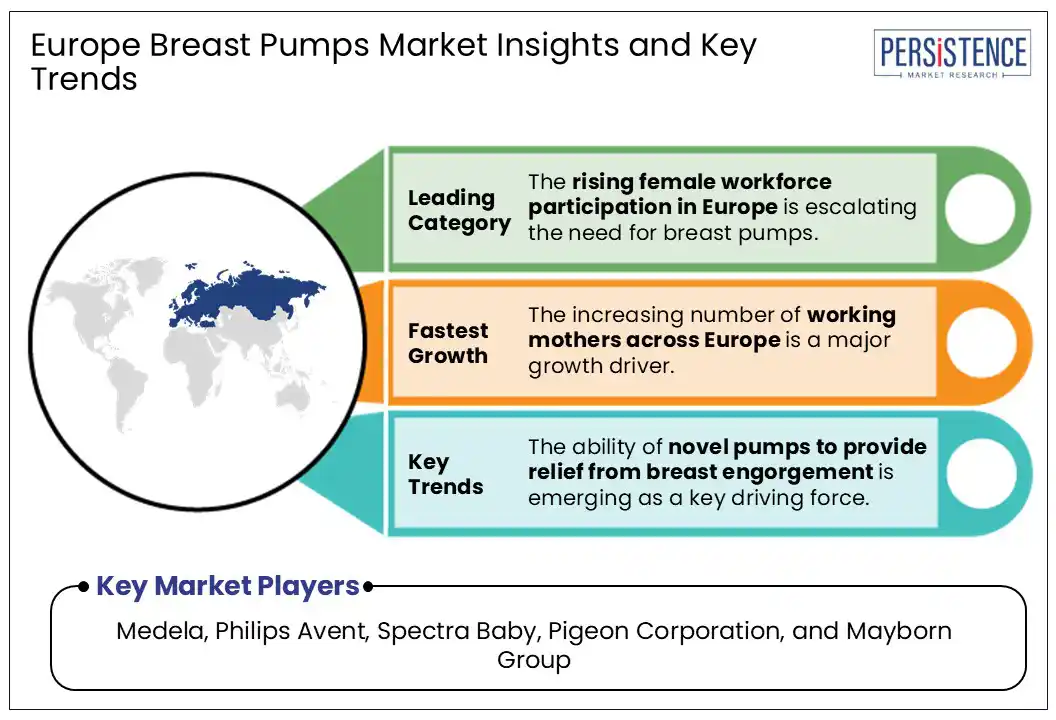ID: PMRREP34885| 173 Pages | 14 Jul 2025 | Format: PDF, Excel, PPT* | Healthcare

Europe breast pumps market size is likely to be valued at US$ 672 Mn in 2025 and is estimated to reach US$ 1,144.7 Mn in 2032, at a CAGR of 7.9% during the forecast period 2025 - 2032.
Breast pumps are essential medical devices that enable lactating mothers to store breast milk conveniently. These devices are useful when direct breastfeeding is not feasible, such as in the case of working women. Ranging from manual to advanced electric and wearable models, these pumps are designed to enhance comfort, efficiency, and mobility for mothers.
Europe breast pumps market growth is driven by a rise in birth rates, increasing participation of women in the workforce, and growing awareness of the benefits of breastfeeding. Technological innovations, such as app connectivity, and hands-free wearable devices are widening consumer choice and reshaping their preferences. The rise of e-commerce and rental programs also enhance accessibility and convenience for users, allowing manufacturers to innovate and cater to the evolving needs of modern mothers.

Key Industry Highlights:
|
Global Market Attribute |
Key Insights |
|
Europe Breast Pumps Market Size (2025E) |
US$ 672 Mn |
|
Market Value Forecast (2032F) |
US$ 1,144.7 Mn |
|
Projected Growth (CAGR 2025 to 2032) |
7.9% |
|
Historical Market Growth (CAGR 2019 to 2024) |
6.7% |
The rise in number of working mothers across European regions fuels the demand. According to Eurostat, a department of the European Commission (EC), in 2021, about 72% of mothers between the ages of 25 and 54 across the European Union (EU) were employed. This number directly translates into increased demand for efficient and time-saving breastfeeding solutions. As more women participate in the workforce and balance their professional responsibilities with the demands of motherhood, there is a growing need for products that enable them to maintain their breastfeeding routines with minimal disruption. The uptake of breast pumps is expected to support the health and well-being of the child, and also the mother's ability to sustain her career. Therefore, favorable employment policies for working mothers is likely to create a better environment for adoption of breast pumps at work.
Europe breast pumps market faces multiple challenges that impede its growth. High costs of advanced wearable and smart breast pumps (€250–€500) and limited insurance coverage restrict affordability, particularly for low-income families. Low breastfeeding rates in countries such as France, alongside cultural barriers and traditional gender roles in Southern Europe, reduce demand. The population in rural areas possess a low-awareness and misinformation about breast pump benefits. Strict EU regulations, such as the Medical Device Regulation, increase compliance costs, deterring new market entrants. The COVID-19 pandemic disrupted supply chains and maternity services, while competition from breast milk substitutes grows due to rising employment and lifestyle changes. Maintenance and hygiene concerns, especially with open-system pumps, deter adoption, and declining birth rates in countries like Spain and Italy shrink the customer base. Economic fluctuations and a shortage of skilled labor for manufacturing further limit innovation and production, challenging the market despite supportive policies and technological advancements.
The expansion of rental and subsidy programs presents an excellent opportunity to enhance product accessibility and drive penetration across diverse socioeconomic groups. Such programs are designed for those who may find the upfront costs of high-quality breast pumps prohibitive. Hospitals, lactation consultants, and specialized medical supply stores are increasingly offering rental options for hospital-grade pumps, providing an affordable way for mothers to access essential technology. Working in tandem is the implementation of state-sponsored initiatives and insurance coverage options for portable breast pumps to alleviate and overcome financial barriers. By making these pumps more affordable and accessible, these programs not only accelerate their wider adoption but also promote breastfeeding as a viable choice for women across the socio-economic spectrum, promoting greater market inclusivity.
By product, Europe breast pumps market has been divided into electric, manual, and battery powered. The electric breast pump segment is anticipated to lead, accounting for approximately 39.5% of the market share during the forecast period. The dominance is aided by the increasing demand by working mothers for efficient, time-saving, and easy-to-use breastfeeding solutions. Hospitals and maternity wards also recommend electric and wearable pumps for mothers facing lactation challenges, further boosting their adoption. Meanwhile, manual pumps still hold some relevance for occasional use, travel, or work as cost-effective alternatives for mothers who pump infrequently.
Based on technology, Europe breast pumps market has been segregated into closed system and open system. Here, closed-system breast pumps are gaining significant traction, as they prevent milk contamination by separating milk from the pump mechanism. Moreover, their hygienic design makes them highly favored among health-conscious mothers and healthcare providers alike. This segment is expected to capture around 60% of the market share by 2025.
On the basis of end-user, Europe breast pumps market segments include working mothers, stay-at-home mothers, and healthcare facilities. Working mothers are likely to be the largest end-user segment over the forecast period, accounting for over 58% of the market share. The rising female workforce participation in Europe, with employment rates around 66-67%, is escalating the need for breast pumps that enable continued breastfeeding despite busy schedules. Supportive workplace policies and growing awareness of breastfeeding benefits across European countries further propel the segment growth.

Competition in Europe breast pumps market is characterized by product innovation, partnerships, and expanded distribution by key players, to deepen their market presence. Leading companies are focusing on launching technologically advanced products, including wearable, app-connected, and Bluetooth-enabled pumps that offer enhanced convenience, comfort, and personalization to meet the evolving needs of modern mothers. Additionally, players are expanding their presence through partnerships with online pharmacies and rental programs.
The Europe breast pumps market is projected to reach US$ 672 Mn in 2025.
The increasing number of working mothers across Europe is the key market driver.
Europe breast pumps market is poised to witness a CAGR of 7.9% from 2025 to 2032.
The expansion of rental and subsidy programs aimed at enhancing product accessibility for families, and the implementation of state-sponsored initiatives and insurance coverage are key market opportunities.
Major players in the Europe Breast Pumps Market include Medela, Philips Avent, and Spectra Baby.
|
Report Attribute |
Details |
|
Historical Data/Actuals |
2019 - 2024 |
|
Forecast Period |
2025 - 2032 |
|
Market Analysis Units |
Value: US$ Bn/Mn, Volume: As Applicable |
|
Geographical Coverage |
|
|
Segmental Coverage |
|
|
Competitive Analysis |
|
|
Report Highlights |
|
|
Customization and Pricing |
Available upon request |
By Product Type
By Technology
By Application
By End-user
By Country
Delivery Timelines
For more information on this report and its delivery timelines please get in touch with our sales team.
About Author